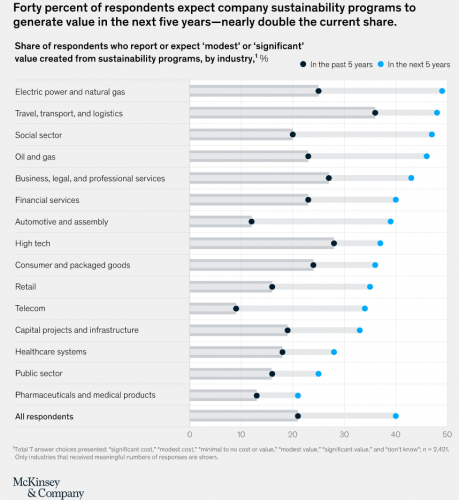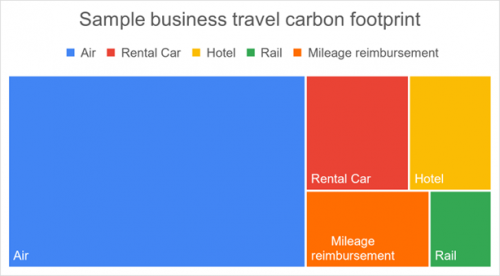Sidebar Module
Polls
Have you started integrating sustainability considerations in your travel policy?
Module 2: Defining Sustainable Travel Management
Module 2: Defining Sustainable Travel Management
 Learning Objectives
Learning Objectives
- This module provides an overview of the opportunities and non-financial costs of business travel for companies.
- Readers will learn what sustainable business travel means and why it is important.
- This module gives insights into the company departments that are involved in the different company sustainability processes.
Business travel is valuable.
Business travel has a history of bringing people together and fostering economic growth across national boundaries. In 2019 the business travel industry itself was worth 1.6 trillion USD according to the World Bank, offering employment and sustaining critical infrastructure for trade and logistics.
From an organization’s perspective, business travel helps to foster company culture and connects teams. It brings crew to their ships, engineers to their sites, doctors to their patients, and artists to their audiences. It builds relationships with new clients, existing clients, and strategic partners in the supply chain.
In short, at its best, business travel fuels growth and retains talent. However, there is also a cost which goes beyond the financial expenses for transport, accommodation, and meals. Security concerns, infectious diseases, time away from home, and unsocial hours have an impact on business travelers. And both transport and accommodation have a significant environmental impact through emissions, noise, pollution, water consumption, and waste. The global transport sector accounts for 25% of all CO2 emissions, aviation for up to 5%, and hospitality another 1%.
From an organization’s perspective, business travel helps to foster company culture and connects teams. It brings crew to their ships, engineers to their sites, doctors to their patients, and artists to their audiences. It builds relationships with new clients, existing clients, and strategic partners in the supply chain.
In short, at its best, business travel fuels growth and retains talent. However, there is also a cost which goes beyond the financial expenses for transport, accommodation, and meals. Security concerns, infectious diseases, time away from home, and unsocial hours have an impact on business travelers. And both transport and accommodation have a significant environmental impact through emissions, noise, pollution, water consumption, and waste. The global transport sector accounts for 25% of all CO2 emissions, aviation for up to 5%, and hospitality another 1%.
What is sustainable business travel?
Broadly, sustainable business travel means enabling people to connect and conduct business while doing what is right for society and the planet. It means capitalizing on the clear value of business travel while also mitigating the costs to the environment and society.
Business travel buyers and suppliers across the globe are making efforts to incorporate sustainability into their business travel policies and practices. Examples of these strategies include (but are not limited to):
- Encouraging environmentally-friendly modes of transportation
- Optimizing efficiency and purpose of trips
- Using virtual alternatives when possible
- Working with sustainable suppliers and vendors
- Identifying opportunities to support and give back to local communities
- Championing equity, diversity, and inclusion (DEI)
- Educating and incentivizing travelers to make sustainable decisions
As detailed in Module 1 , there is a clear environmental case for sustainable business travel. However, there are also commercial and social drivers to pursue a more sustainable travel program. Sustainable practices have been shown to:
- reduce uncertainty and limit risk (e.g., by preparing for future regulations or for shortage of capacity)
- reduce costs and use resources more efficiently
- enhance the brand and reputation of a company among customers, shareholders, and employees
- improve the work-life balance of employees
- support the company’s own offerings of new products and services in the growth market of sustainability (sustainability can help organizations boost overall sales revenues up to 20%)
In GBTA’s landmark report, “The State of Sustainability in the Global Business Travel Sector,” the majority of industry professionals surveyed identified climate change as the number one priority area for action. While sustainable travel management encompasses all pillars of ESG, this toolkit focuses on what travel managers can do to advance climate action specifically.
How can travel managers advance climate action?
Companies adopting the Net-Zero Standard developed by the Science Based Targets initiative (SBTi) are required to set both near-term and long-term science-based targets.
- This means making rapid emissions cuts now, halving emissions by 2030.
- Most companies are required to have long-term targets with emission reductions of at least 90-95% by 2050.
For many companies, this means they are now developing holistic, company-wide climate action plans. A key aspect of these plans will be a sustainable business travel program and reporting on their Scope 1, 2, and 3 emissions. As discussed in Module 1, business travel can be a major component of a company’s Scope 3 emissions. Examples of this might be emissions related to air/car/rail travel, hotels, waste, meeting and event spaces, etc. (Business travel does not always fall under Scope 3, however. An example of this would be travel conducted in a company-owned car.)
As part of a company’s overall climate action planning and reduction efforts, it is vital to measure the carbon footprint of business travel activities. In other words, you cannot manage what you cannot measure. But what makes calculating business travel emissions challenging is that, as Scope 3 emissions, these are not owned or controlled by the company. Although it is complex, it is important to account for this data, as the majority of most companies’ emissions lie outside of their own operations (see Module 4).
Travel managers are at an important nexus point because they can reduce emissions related to business travel directly. They can reduce and avoid emissions by managing traveler demand, considering virtual alternatives, influencing traveler behavior, and other strategies (see Module 8). However, travel managers can also play a role in indirectly reducing emissions by leveraging partnerships along the business travel supply chain. Transport, accommodation, and venue suppliers, for example, can make decisions to invest in more fuel-efficient aircraft, provide electric car rentals, or implement waste reduction initiatives. Increasingly, buyers are choosing to work with suppliers who adhere to sustainability criteria.
On a journey of such importance, it’s best to travel together.
Successful travel managers have the power of orchestrating a complex ecosystem of partners, suppliers, and technology players typically with a view to achieve a great user experience, savings, and duty of care. They now can leverage their partnerships to integrate sustainability across the value chain.
Other corporate functions have often already been tasked to address sustainability. However, their perspective, metrics, approach, and jargon might be different, so it is imperative to actively collaborate with those to join forces and drive change.
Internally, the most obvious corporate friend is the sustainability department if you have one. HR is a great partner, as sustainability is increasingly important to attract and retain talent. Investor Relations and Marketing functions have a key interest given their need to communicate action and progress to stakeholders. Another close business partner for Travel around the topic of Sustainability is the Real Estate and Workplace Services teams. They manage another form of transportation at several companies - commuting. The closer a travel manager can get to linking sustainability to the way the company works and its articulated objectives, the more impactful the actions will be.
And don’t stop with internal stakeholders. Your TMC and technology providers have a key role to play in achieving your objectives. You need them to nudge travelers during trip planning and booking to make informed decisions. You need their data points to understand and drive behavior and to report on progress. Travel suppliers - from transportation providers, to accommodation, and venues - are critical to reduce the negative impact traveling has on the environment and the climate. They need to understand that sustainability is important to you, what you expect from them and how you measure results. They also need to understand that you hold them accountable for keeping their commitment to sustainability.
The journey towards sustainable travel management can be broken into a step-by-step guide. To help you get started taking the first steps visit Module 3.
Other corporate functions have often already been tasked to address sustainability. However, their perspective, metrics, approach, and jargon might be different, so it is imperative to actively collaborate with those to join forces and drive change.
Internally, the most obvious corporate friend is the sustainability department if you have one. HR is a great partner, as sustainability is increasingly important to attract and retain talent. Investor Relations and Marketing functions have a key interest given their need to communicate action and progress to stakeholders. Another close business partner for Travel around the topic of Sustainability is the Real Estate and Workplace Services teams. They manage another form of transportation at several companies - commuting. The closer a travel manager can get to linking sustainability to the way the company works and its articulated objectives, the more impactful the actions will be.
And don’t stop with internal stakeholders. Your TMC and technology providers have a key role to play in achieving your objectives. You need them to nudge travelers during trip planning and booking to make informed decisions. You need their data points to understand and drive behavior and to report on progress. Travel suppliers - from transportation providers, to accommodation, and venues - are critical to reduce the negative impact traveling has on the environment and the climate. They need to understand that sustainability is important to you, what you expect from them and how you measure results. They also need to understand that you hold them accountable for keeping their commitment to sustainability.
The journey towards sustainable travel management can be broken into a step-by-step guide. To help you get started taking the first steps visit Module 3.
 Key Takeaways
Key Takeaways
- Business travel fuels company growth and helps retain talent, but it also carries costs both financially, socially, and environmentally.
- Environmental concerns, adhering to regulations, and improving company reputation have led companies to increasingly look into integrating sustainable practices into their business models.
- Broadly, sustainable business travel means enabling people to connect and conduct business while doing what is right for society and the planet.
- To make the transition to sustainable business travel models, it is recommended to establish partnerships with the company's sustainability and human resources department, investors, your TMC, technology providers, and other suppliers.
- Travel managers have the spending power to develop the right partnerships with sustainable suppliers in order to drive sustainable business travel.
Custom Block
Polls
Have you started integrating sustainability considerations in your travel policy?

